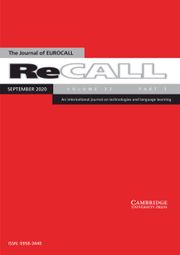Crossref Citations
This article has been cited by the following publications. This list is generated based on data provided by
Crossref.
Williams, Lawrence
Abraham, Lee B.
and
Bostelmann, Evan D.
2014.
A Discourse‐Based Approach to CALL Training and Professional Development.
Foreign Language Annals,
Vol. 47,
Issue. 4,
p.
614.
Fuchs, Carolin
2015.
Needs Analyses and Reflection Logs in Telecollaboration.
The FLTMAG,
Bueno-Alastuey, M.C.
and
Kleban, M.
2016.
Matching linguistic and pedagogical objectives in a telecollaboration project: a case study.
Computer Assisted Language Learning,
Vol. 29,
Issue. 1,
p.
148.
Dooly, Melinda
and
Tudini, Vincenza
2016.
‘Now we are teachers’: The role of small talk in student language teachers’ telecollaborative task development.
Journal of Pragmatics,
Vol. 102,
Issue. ,
p.
38.
Martí, Natalia Morollón
and
Fernández, Susana S.
2016.
Telecollaboration and sociopragmatic awareness in the foreign language classroom.
Innovation in Language Learning and Teaching,
Vol. 10,
Issue. 1,
p.
34.
Gonzalez-Acevedo, Nathaly
2016.
Technology-enhanced-gadgets in the Teaching of English as a Foreign Language to Very Young Learners. Ideas on Implementation.
Procedia - Social and Behavioral Sciences,
Vol. 232,
Issue. ,
p.
507.
Farrell, Thomas SC
2016.
Anniversary article: The practices of encouraging TESOL teachers to engage in reflective practice: An appraisal of recent research contributions.
Language Teaching Research,
Vol. 20,
Issue. 2,
p.
223.
Jauregi, Kristi
2016.
Technology Implementation in Second Language Teaching and Translation Studies.
p.
155.
Tanghe, Shannon
and
Park, Gloria
2016.
“Build[ing] something which alone we could not have done”: International collaborative teaching and learning in language teacher education.
System,
Vol. 57,
Issue. ,
p.
1.
Sadler, Randall
and
Dooly, Melinda
2016.
Twelve years of telecollaboration: what we have learnt.
ELT Journal,
Vol. 70,
Issue. 4,
p.
401.
Fuchs, Carolin
2016.
“Are you able to access this website at all?” – team negotiations and macro-level challenges in telecollaboration.
Computer Assisted Language Learning,
Vol. 29,
Issue. 7,
p.
1152.
Fernández, Susana S.
and
Pozzo, María Isabel
2017.
Intercultural competence in synchronous communication between native and non-native speakers of Spanish
.
Language Learning in Higher Education,
Vol. 7,
Issue. 1,
p.
109.
Priego, Sabrina
and
Liaw, Meei-Ling
2017.
Listening to the Multiple Voices in an Intercultural Telecollaborative Multilingual Digital Storytelling Project: A Bakhtinian perspective.
Alsic,
Vol. Vol. 20, n° 2,
Issue. ,
Dooly, Melinda
2017.
Qualitative approaches to research on plurilingual education / Enfocaments qualitatius per a la recerca en educació plurilingüe / Enfoques cualitativos para la investigación en educación plurilingüe.
p.
212.
Parmaxi, Antigoni
and
Zaphiris, Panayiotis
2017.
Web 2.0 in Computer-Assisted Language Learning: a research synthesis and implications for instructional design and educational practice.
Interactive Learning Environments,
Vol. 25,
Issue. 6,
p.
704.
Vinagre, Margarita
2017.
Developing teachers' telecollaborative competences in online experiential learning.
System,
Vol. 64,
Issue. ,
p.
34.
Arnold, Nike
2017.
Language and Technology.
p.
1.
Gallardo, Matilde
Heiser, Sarah
and
Arias McLaughlin, Ximena
2017.
Developing pedagogical expertise in modern language learning and specific learning difficulties through collaborative and open educational practices.
The Language Learning Journal,
Vol. 45,
Issue. 4,
p.
518.
Zhang, Yining
and
Deroo, Matthew
2017.
Preparing Foreign Language Teachers for Next-Generation Education.
p.
1.
Ensor, Simon
Kleban, Marcin
and
Rodrigues, Christine
2017.
Telecollaboration: foreign language teachers (re)defining their role.
Alsic,
Vol. Vol. 20, n° 2,
Issue. ,

